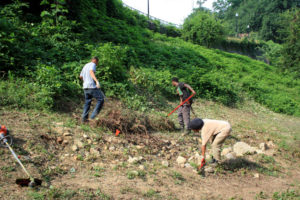THE PARKS OF ADAMS MORGAN include Kalorama Park and Walter C. Pierce Community Park. Rock Creek National Park forms our western boundary. Our smallest public green space is the Biltmore Triangle Garden.
KALORAMA PARK, a three-acre wooded slope and hilltop, sits at the highest point in the neighborhood, on the north side of Columbia Road between Kalorama Road and Mintwood Place. Neighbors love to watch the sun set over Rock Creek Valley from the park’s western hillside. Its central grassy oval was the site of a 19th century manor house, which served as the operational center of a large slave-holding farm. Today, Kalorama Park has two newly renovated playgrounds, and a basketball court, community garden, small shelter house and plaza. It was dedicated in 1949, after the Kalorama Citizens Association spent decades lobbying for a neighborhood park. In recent years, members of KCA have documented the site’s important history as part of John Little’s slave-holding farm. The National Park Service in 2008 named Kalorama Park a National Underground Railroad Network to Freedom site; the park is listed also on DC’s African American Heritage Trail. Kalorama Park’s cultural history, coupled with the archaeological ruins of the slave-holding farm that still lie just under the ground, led the city to nominate the site to the National Register of Historic Places in 2015. (Click here to read the Kalorama Park Underground Railroad nomination. For a full history of the site, read the Kalorama Park National Register nomination.)
WALTER C. PIERCE COMMUNITY PARK is a three-acre park tucked behind the row houses on the north side of Calvert Street, between Biltmore Street and Adams Mill Road. It abuts the National Zoo and Rock Creek Park. The park is named for the late community activist Walter Pierce, a tireless African American youth mentor. In the mid-1960s, after developers abandoned long-held plans to build several apartment buildings at the site, Pierce and others established a “People’s Park” on the vacant land, using it for soccer, basketball and family picnicking. Walter Pierce and his compatriots fended off developers’ renewed attempts to build at the site in the late 1970s by successfully persuading Congress and the city to buy the land to create the park. It was dedicated as “Community Park West” in 1978. Today, Walter Pierce Park has a large soccer field, playground, dog park, and picnic benches.The park site is steeped in history. It was the site of Washington’s only Quaker burial ground, founded in 1807. From 1823 to 1870, the park site was owned by John Quincy Adams and his heirs as part of their mill property along Rock Creek. During the Civil War, it was the site of Cliffburne Hospital and the headquarters for the Veterans Reserve Corps. From 1870 to 1890, it was Mt. Pleasant Plains Cemetery, a multi-denominational African American cemetery where at least 8,428 people were buried. In 2005, community activists stopped a major earth-moving project at the park because of its history as an African American and Quaker burial ground. A grassroots coalition of concerned community members, the descendants of the buried, and Howard University archaeologists worked to document and protect any unmarked graves that remain.The Kalorama Citizens Association sponsors regular commemorative events at the park and has supported the efforts of the Walter Pierce Park Archaeology Project since its inception in 2005. For more information, go to walterpierceparkcemeteries.org. If you would like to be added to the e-mail list for park events, contact Mary Belcher, [email protected]. If you would like to make a tax-deductible donation to the project, make a check out to KCA and put on the notation line “Walter Pierce Park Archaeology Project” and mail it to KCA, P.O. Box 21311, Washington, DC 20009. To donate by credit card through PayPal, go to Join & Donate.
THE BILTMORE TRIANGLE GARDEN at the intersection of 20th and Biltmore streets bursts forth with roses, irises, tulips and other flowers for most of the year, from 10 small plots tended by neighborhood gardeners. The Kalorama Citizens Association accepts tax-deductible donations to fund their needs.The Biltmore Triangle Garden was designed in 1981 by Gordon Riggle, a noted landscape architect and one-time neighborhood resident. If you enjoy the symphony of colors, textures, and designs in the garden and appreciate the work of the volunteers, you can make a donation to provide for its continuing beauty. Make a check out to KCA, with “Biltmore Triangle Garden” on the notation line, and send it to KCA, P.O. Box 21311, Washington, DC 20009. To donate by credit card through PayPal, go to Join & Donate. If you would like to become part of the gardening community, contact Marianne Josem at [email protected].




